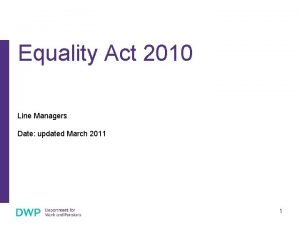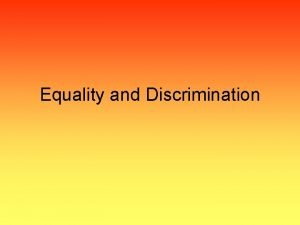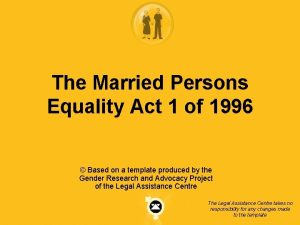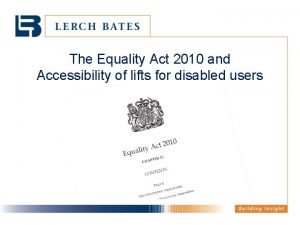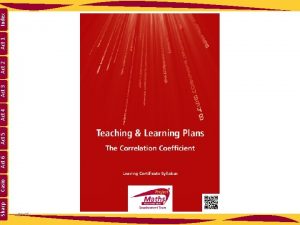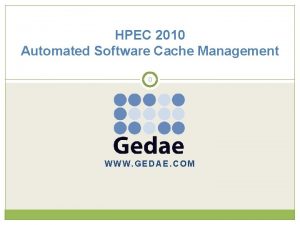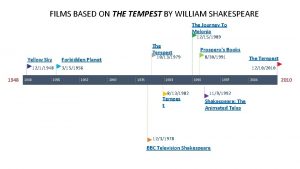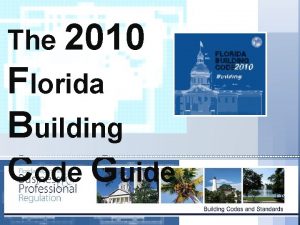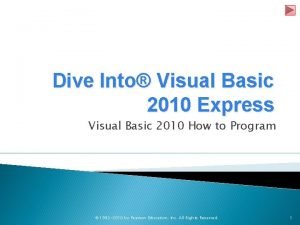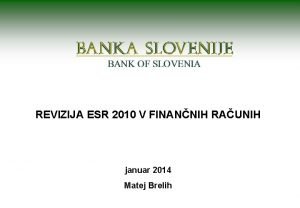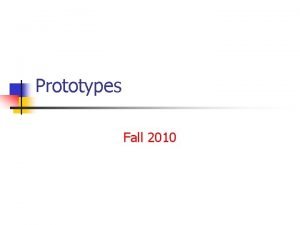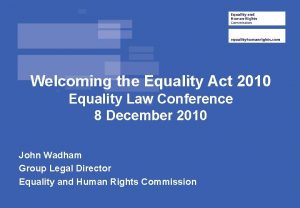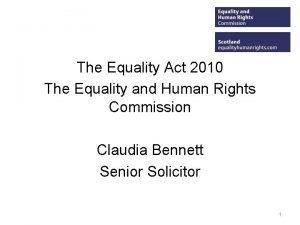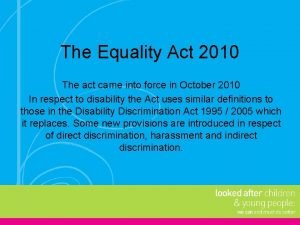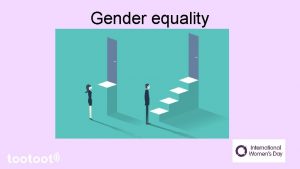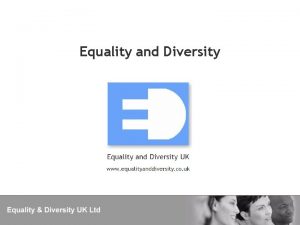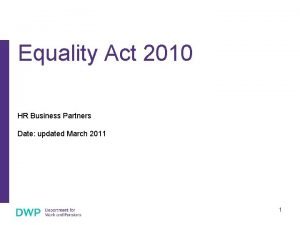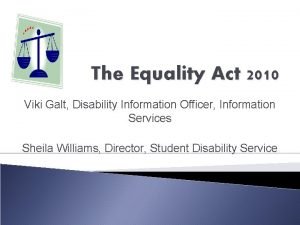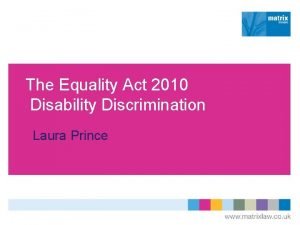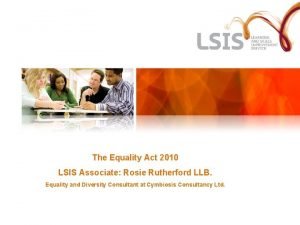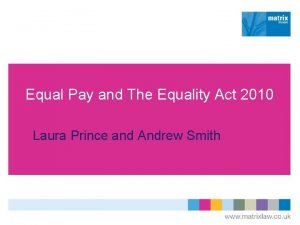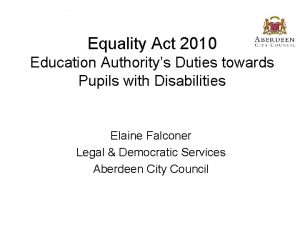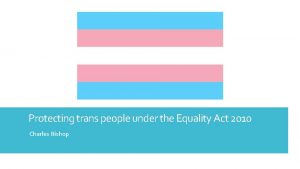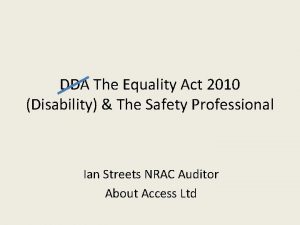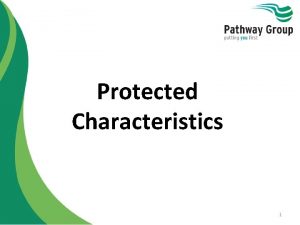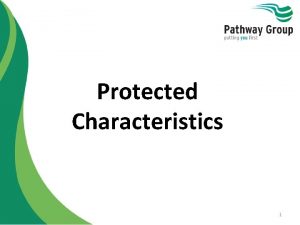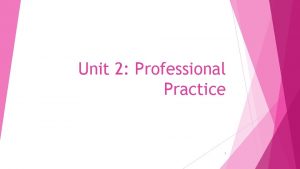Equality Act 2010 What is Equality What is



































- Slides: 35

Equality Act 2010

What is Equality?

What is Equality? Equality is ensuring individuals or groups of individuals are treated fairly and equally, and no less favourably, specific to their needs. (Edinburgh University)


What is Diversity? Diversity means variety. A society that values diversity appreciates people’s differences and believes that everyone can make a positive contribution. Recognising diversity promotes an inclusive culture for all. (Edinburgh University)

The Equality Act 2010 Background – This Act brought together hundreds of separate pieces of legislation and regulations including: � The Sex Discrimination Act 1975 � The Race Relations Act 1976 � The Disability Discrimination Act 1995. � These are now superseded by the Equality Act 2010

Who is protected by the Act?

Who is protected by the Act? EVERYONE! This is because 2 of the 9 protected characteristics are Age and Sex The others are: - Disability - Gender Reassignment - Marriage and Civil Partnership Status - Pregnancy and Maternity - Race - Religion and Belief - Sexual Orientation

Discrimination 5 main categories – � Direct Discrimination � Indirect Discrimination � Victimisation � Harassment � Discrimination arising from a disability

Discrimination People are also protected by law by association or perception either • Treated less favourably because of an assumption that they hold one or more of these characteristics or – • Are treated less favourably because they associate with someone who has one or more of these characteristics

Discrimination Examples Direct Discrimination�The treatment of a person less favourably because of a protected characteristic

Discrimination Examples Indirect Discrimination – Arises out of inappropriate conditions (eg rules, practices or policies) that are applied to everyone but in practice place people who share a Protected Characteristic at a disadvantage � Failing to provide religiously appropriate food when catering – indirect discrimination on grounds of religion or belief � Failure to provide gender appropriate services – indirect discrimination on the grounds of sex

Discrimination Examples

Discrimination Examples Victimisation: Where a person is treated badly as a result of raising a grievance or making a complaint regarding discrimination, or supporting a grievance or complaint

Examples of Victimisation: � You make a complaint to the school of your disabled son about his unfair treatment by some of the staff. You meet with the head teacher and the problem is resolved. However, you’ve now been told that you can’t help out at school any more even though you’ve long been an active parent helper. You believe this is because you complained about your son’s treatment. � Also victimisation as a result of whistleblowing.

Discrimination Examples Harassment – � When someone subjects another person to unwanted behaviour related to a protected characteristic that has the purpose or effect of violating that person’s dignity or creating an intimidating, hostile, degrading, humiliating or offensive environment. � Used interchangeably with bullying

Examples of Harassment � Spreading malicious rumours, or insulting someone with words or behaviour � Copying memos that are critical about someone to others who do not need to know

Examples of Harassment � Unwelcome sexual advances – touching, standing too close, the display of offensive materials, asking for sexual favours, making decisions on the basis of sexual advances being accepted or rejected � Deliberately undermining a competent worker by overloading and constant criticism � Preventing individuals progressing by intentionally blocking promotion or training opportunities

Discrimination Examples Discrimination arising from a disability

Discrimination is not always deliberate and not always face to face � Sometimes people discriminate without thinking – they may not realise that their words and behaviour are upsetting or can cause offence � Effect of Social Media � Negative - “cyberbullying” � Positive – UKYP “Don’t Hate, Educate!” Campaign. content on Facebook and Twitter that will challenge negative images of race and religion and promote diversity and inclusion within communities.

Deliberate Discrimination � Verbal abuse or using words that are unacceptable eg ‘queer’ ‘spastic’ ‘Paki’ ‘crazies’ ‘headcase’ etc � Language and attitude – ‘they do not belong here’ ‘should go back from where they came from’ or ‘people like them should be locked up’ � Excluding or making fun of people because they belong to a particular group � Violence towards people because they belong to a particular group

Values and Ethics � Our own beliefs and values are influenced by our own upbringing from family, early experiences, school, media, wider society etc � One way to challenge our beliefs is to see the whole person rather than use stereotypes and assumptions to form our view � Treat people as individuals – links to Personalisation Agenda

Values and Ethics � It is necessary to think about our own values and how they may be at odds with other people � Links to PCF KSS So. Ps - Core Social Work Values – Anti-discriminatory practice (ADP) � Importance of Critical Reflection - challenge own values, systemic values, organisational values and societal values

Values and Ethics International Federation of Social Workers Definition of Social Work: The social work profession promotes social change, problem solving in human relationships and the empowerment and liberation of people to enhance well-being. Utilising theories of human behaviour and social systems, social work intervenes at the points where people interact with their environments. Principles of human rights and social justice are fundamental to social work.

Challenging Discrimination Inclusion means ensuring that everybody has the same opportunity to take part fully in their community and wider society – this involves making sure there are no barriers/obstacles preventing people from being included.

Inclusion

Practices that support inclusion: � Enabling worship in Church / Chapel / Mosque / Synagogue / Temple etc � Suitable and accessible information eg Braille / subtitles / large print / different languages � Accessible buildings � Same sex partners treated the same as opposite sex partners � Taking account of cultural dietary needs � Non sexist activities � Involving others: family, carers etc to provide an holistic approach to care

Reasonable Adjustments (RA) � These are a key part of the Eq. A and can be essential to enabling a disabled person � Obligation to make RA in relation to: - Provisions, criteria or practices, including company policies - Physical features, such as layout and access - Provision of auxiliary aids, eg Braille, large format, email etc

Reasonable Adjustments (RA) Employment practices: � Relaxing absence rules and limits for those with disability related sickness absence � Excluding disability related absence from calculations of when half or no pay is appropriate � Revising flexible working hours rules, especially core times, to allow travelling outside of rush hours � Accepting lower levels of output, accuracy etc.

Reasonable Adjustments (RA) Examples of possible adjustments: � Making adjustments to premises � Allocating some of the disabled person’s duties to another person � Transferring him/her to fill an existing vacancy � Altering his/her hours of work or training � Assigning him/her to a different place of work or training � Allowing him/her to be absent during work for rehabilitation, assessment or treatment

Reasonable Adjustments (RA) Examples of possible adjustments: � Giving, or arranging for, training or mentoring (whether for the disabled person or any other person) � Acquiring or modifying equipment � Modifying instruction or reference manuals � Modifying procedures for testing or assessment � Providing a reader or interpreter � Providing supervision or other support.

Each case will be judged on its own merits. Issues to bear in mind include: � Ensure the member is likely to meet the definition of disability within the Eq. A � Any prejudicial action can be classed as discrimination � Consider any facility for disability leave if such a system exists, or request paid special leave, if the individual would be fit to work in a suitably adjusted environment � More information from Equality Challenge Unit: www. ecu. ac. uk/. . . /managing-reasonable-adjustments-inhigher-education

Discussion & Reflection RA - How do you think this relates to students? For example - reducing the hours of work for someone who is disabled. How might this fit with the requirements of a 70 or 100 day placement? Consider the needs of a disabled student in your team – eg a wheelchair user, someone with hearing or visual impairment or someone with a diagnosis of OCD

Penultimate Slide Unconscious Bias – we all have it. We must be honest and recognise this Links in with Social Work Values and our standards It is our responsibility as Citizens but also as Social Care Professionals to challenge discrimination where we find it.

A positive note………………. .
 Equality act 2010
Equality act 2010 Formal and substantive equality
Formal and substantive equality Formal equality vs substantive equality
Formal equality vs substantive equality Macbeth act 2 summary
Macbeth act 2 summary What is drrm act
What is drrm act Sasrea act 2 of 2010
Sasrea act 2 of 2010 Married persons equality act 1 of 1996
Married persons equality act 1 of 1996 Equality act lift
Equality act lift Summary of othello act 1 scene 3
Summary of othello act 1 scene 3 R. a 9344
R. a 9344 Act 6 act 4
Act 6 act 4 Give at least 4 modifiers of the human acts
Give at least 4 modifiers of the human acts Title act interior design
Title act interior design Macbeth act 4 setting
Macbeth act 4 setting S a t c quadrants
S a t c quadrants Act 2 vs act 120
Act 2 vs act 120 Perfect voluntariness example
Perfect voluntariness example Act 6 act 5
Act 6 act 5 Pharmacy order 2010
Pharmacy order 2010 Bell trade act
Bell trade act Band aid ethiopia
Band aid ethiopia Hpec 2010
Hpec 2010 Excel 2010
Excel 2010 Films based on the tempest
Films based on the tempest Florida building code 2010
Florida building code 2010 Pearson education inc. publishing as prentice hall
Pearson education inc. publishing as prentice hall 2010 ygs sonuçları
2010 ygs sonuçları Excel 2010 kullanımı
Excel 2010 kullanımı Visual studio 2010 express
Visual studio 2010 express Visual basic 2010 express registrierungsschlüssel
Visual basic 2010 express registrierungsschlüssel Esr 2010
Esr 2010 Nnnn 2010
Nnnn 2010 Ul 2010
Ul 2010 Copyright 2010 pearson education inc
Copyright 2010 pearson education inc March 22 2010
March 22 2010 Irizar 2010
Irizar 2010
